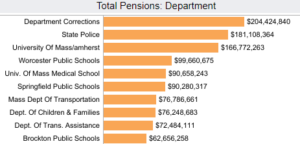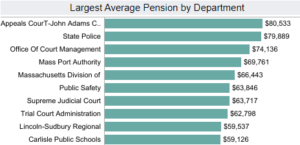Where Does Massachusetts’ Pension Money Go?
In 2023, the Commonwealth’s two largest public pension funds, the Teachers Retirement System and the State Employees Retirement System, paid over $6 billion to retirees. Pioneer Institute’s MassOpenBooks data transparency tool sheds light on where this money is going.
Fund Comparison
The Teachers Retirement System paid over $3.4 billion in pension payments to former teachers and administrators in 2023. The fund paid an average pension of $50,177 to 68,773 retirees. The State Employees Retirement System paid over $2.7 billion to their 64,297 retirees last year. The fund’s average pension payment was $43,302. Over time, the total pension expense and average pension payment for both funds have steadily increased.


Who Gets the Most: Total
In 2023, retirees from the Department of Corrections collected the most among the departments receiving pension payments from these two funds. The total pensions of retirees from the State Police and UMass Amherst were the second and third highest, respectively. Worcester Public Schools and UMass Medical School rounded out the top five, while two more public school systems and three state agencies made their way into the top 10.
The fact that the total pensions of retirees of the Department of Corrections and the State Police were the highest and second highest in the state in 2023 is related to group classification, as the Department of Corrections is in Group 4 for pensions and the State Police is in Group 3. This means that they may receive richer pensions than many other state employees depending on factors such as title, experience, and age at retirement.

Who Gets the Most: Average
The State Police was the only department in the top 10 for total pensions paid to their retirees that was also in the top 10 for highest average pension payments for departments with more than 50 retirees. Four out of the top 10 highest average pensions belong to retirees from judicial departments, as Appeals Court retirees had the highest average pension.
In addition to the State Police, three other law enforcement departments made their way into the top 10 for average pensions for departments of more than 50 retirees. A division of the State Police, MassPort, and Public Safety all had some of the highest average pensions in the state in 2023.
Outside of the judicial system and law enforcement, the last two spots of the top 10 highest average pensions in Massachusetts were occupied by two public school systems. Retirees from Lincoln-Sudbury Regional had the ninth highest average pensions in the state, while retirees from nearby Carlisle Public Schools had the 10th highest.

Who Gets the Most: Individuals
Interestingly, none of the retirees who received the largest individual pensions in 2023 received their pension as a result of their work with any of the departments in the top 10 for average pensions. In fact, all of them received their pension courtesy of their contributions to the University of Massachusetts system.
The largest individual pension in 2023 belonged to Thomas Manning, who worked for UMass Medical School. Three other retirees who had pensions among the 10 largest in the state also worked for UMass Medical School. Three of the retirees in this group, Derek Lovley, John McCarthy, and James Kurose, were professors at UMass Amherst. Jaqueline Moloney and Jean McCormack were former chancellors of UMass Lowell and UMass Dartmouth, respectively. Former Massachusetts Senate President William Bulger received his large pension due to his tenure as president of the entire UMass system.

Conclusion
Despite formerly employing some of the highest pension earners in the state, retirees from neither UMass Amherst or UMass Medical School receive among the 10 highest average pensions. Furthermore, only one of the departments whose retirees’ total pensions are among the 10 highest in the state is among the top 10 highest average pensions.
Not surprisingly, how much one receives in pension payments depends on many factors outside of the department where one was formerly employed. The over $6 billion in pensions being paid by the state’s two largest pension funds go to many places, and of course, that disbursement is far from equal.
About the Author
Matt Mulvey is a Roger Perry Transparency Intern at Pioneer Institute. He is a rising senior at Swarthmore College where he is political science major and history minor.



